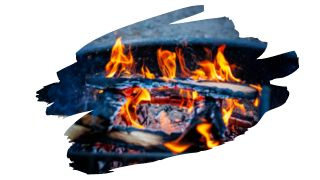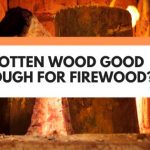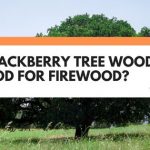You can get free firewood pretty much anywhere. In fact, you may live in an area that has a lot of trees that are suitable for burning.
But, is Boxelder one such possible source of firewood?
Also known as the Ash-Leaved Maple, Boxelder trees can be found growing all around the United States and Canada. And it’s even found growing in parts of Great Britain too.
But, just because wood might be easily accessible doesn’t necessarily make it a great choice firewood. So, how does Boxelder really stack up as a source of home-heating fuel?
Well, in this post, you’ll learn what you should really be checking for, if you want clean burning firewood. You will also discover exactly how much energy it takes to burn a cord of Boxelder.
And keep reading to find out which North American hardwoods are the best sources of fuel for your homestead.

This post may contain affiliate links to products that we receive a commission for (at no additional cost to you). Learn more here.
What Type Of Wood Burns The Cleanest?
Clean burning firewood needs to be dry, and it needs to be free of any sticky tree resin. And, most importantly, it must not be sourced from a poisonous tree species.
Those three criteria are key if you want firewood to safely burn in your fireplace. However, if you want firewood to produce plenty of heat as well, then it also needs to be fairly dense.
Dense hard timber burns for longer. And if it burns longer, it can produce more heat for your home.
So, some of the best sources of firewood are White Oak (referred to as European Oak across the ocean), and Birch.
Related Post: Is Sugar Maple Wood Good Firewood?
What About Smoke? How Do You Reduce Smoke Emissions?
Thick smoke emissions is the result of moisture evaporating and turning into steam. The steam thickens up the smoke, making it lung clogging.
So, if you want to reduce the amount of smoke, you need to only use wood that’s dry.
Drying out firewood is called ‘seasoning’. And it involves allowing freshly cut lumber to sit and air-out for around 6-12 months.
Related Post: How To Season Wood (7 Tips)
OK…And What Kind Of Firewood Should Not Go Into A Fireplace?
Well, it’s worth reiterating here that you must never burn wood from a poisonous tree. The toxic compounds found in these trees don’t simply disappear when you burn them. Instead, they’ll gather up in the soot, smoke and fumes.
And these toxic compounds are much too harmful to risk inhaling.
Another type of wood that should not be in your fireplace, (especially ones with a chimney), are sap-saturated timbers.
Wood types with a lot of tree sap or pitch, (such as Cedar and Spruce), can increase the risk of chimney fires. That is because that thick resinous tree sap can collect in the soot lining your chimney flue.
This can cause chimney blockages, which in turn can cause a fire.
Good To Know…What About Boxelder? This Wood Is Safe To Burn In A Fireplace, Right?
Yes it is. While the seeds from this particular tree are toxic to some animals, it’s lumber is safe to burn.
And even though the Boxelder is a Maple, (it’s not called the Ash-Leaved Maple for nothing), it’s tree sap isn’t thick. In fact, like most Maple trees, the sap from this tree species is fairly watery.
In other words, it’s sap is no where near as thick as the sap found in Cedar or Spruce.
Having said all of this, it probably isn’t worth bothering stacking up high on Boxelder firewood. Why? Well, because it doesn’t produce much heat.
And How Much Heat Does Boxelder Produce?
When it comes to firewood, (if you want to know how much heat it produces), you need to check it’s BTU. The BTU (British Thermal Unit) measures how much energy it takes for fire to burn a cord of wood.
The higher the BTU, then the more energy it takes. And the more energy it takes, then the longer that wood will burn.
And if wood takes a long while to burn, that means it will produce heat for a lot longer too.
Now, low BTU woods don’t burn for very long, making them good for kindling — but little else. And, when it comes to Boxelder, this is also the case.
Boxelder has a BTU of 18.3, which isn’t that bad until you compare it against much better firewood sources. White Oak has a BTU of 25.7, and Birch wood has a 23.6 BTU rating.
Even Boxelder’s Maple tree cousin, Hard Maple (a.k.a. Sugar Maple), surpasses it, what with it’s 24.0 BTU.
Wait…Does That Mean I Shouldn’t Bother With Boxelder?
Not at all. In fact, if you can get a ready free supply of Boxelder firewood, it is as good as any to burn.
Nevertheless, this all changes if you’ll be needing to spend a fair amount of time (or money) accessing Boxelder firewood. In which case, you’re much better off checking elsewhere for a source of fuel.
Related Post: Is Mulberry Tree Wood Good For Firewood?
To Wrap Up, Here Are The 3 Key Takeaways From This Post…
- 1). Only use clean burning firewood in your fireplace. This means using firewood that is dry, and does not contain lots of thick tree sap.
- 2). Boxelder wood is safe to burn in your homes fireplace. However, this particular sub-species of Maple doesn’t produce that much heat compared to other North American hardwoods.
- 3). Boxelder makes for good kindling. Still, for optimal home-heating firewood, you’re better off using White Oak or Birch wood.
References:
Wood Smoke Awareness | EPA.gov
Wood Heating | Forestry.usu.edu



